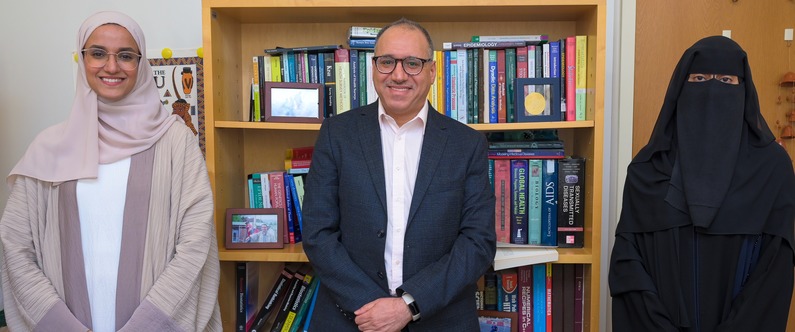WCM-Q research provides first detailed study of herpes simplex virus type 2 prevalence in Europe
 The study by WCM-Q researchers Aisha Osman, left, Dr. Laith Abu-Raddad and Asalah Alareeki probed the prevalence of the herpes simplex type 2 virus in Europe.
The study by WCM-Q researchers Aisha Osman, left, Dr. Laith Abu-Raddad and Asalah Alareeki probed the prevalence of the herpes simplex type 2 virus in Europe.
A study entitled ‘Epidemiology of herpes simplex virus type 2 in Europe: Systematic review, meta-analyses, and meta-regressions’ has been published in the prestigious journal Lancet Regional Health-Europe by researchers at Weill Cornell Medicine-Qatar (WCM-Q).
The study found that about 10 percent of the population of Europe is infected with the herpes simplex virus type 2 (HSV-2). HSV-2 prevalence is declining in Europe, but at a relatively slow rate of 1 percent per year, lower than that in other world regions. The prevalence was more common in women than men.
The study was conducted by the Infectious Disease Epidemiology Group (IDEG) at WCM-Q to address one of the goals of the World Health Organization (WHO)’s Global Health Sector Strategy on Sexually Transmitted Infections. The study provided the first such detailed description of HSV-2 epidemiology in Europe.
Asalah Alareeki, joint first author of the study and researcher at IDEG, stated: “We applied rigorous methodologies to assess the epidemiology of HSV-2 in Europe and found that HSV-2 prevalence in the adult population of Europe averaged at about 12 percent, but this prevalence has been declining at a rate of 1 percent per year over the last three decades. Despite the declining sexual transmission of this infection, there was an increasing trend of neonatal herpes of mothers transmitting herpes infections to their newborns.”
HSV-2 infection is a globally prevalent sexually transmitted infection. Although asymptomatic in most people, it can cause a range of symptoms and adverse health outcomes, such as recurrent painful genital ulcers and serious neonatal infections. HSV-2 infection is linked to increased risk of acquiring and transmitting HIV infection.
The study was supported by the Qatar National Research Fund through the National Priorities Research Program [NPRP 9-040-3-008] and pilot funding from the Biomedical Research Program at Weill Cornell Medicine-Qatar.
Aisha Osman, joint first author of the study and researcher at IDEG, said: “We found that one-fifth (22 percent) of genital ulcer disease cases and two-thirds (66 percent) of genital herpes cases were caused by HSV-2 infection. Our findings call for implementation of preventive and control measures to tackle this infection by 2030 and achieve the main goals of the WHO’s Global Health Sector Strategy on Sexually Transmitted Infections.”
Dr. Laith Abu-Raddad, principal investigator of the study and professor of population health sciences at WCM-Q, concluded: “Despite the large disease burden of this infection, we still have no vaccine to tackle its global prevalence. These findings demonstrate the need to accelerate HSV-2 vaccine development.”
Key scientific findings of the study
- 12% of the adult general population in Europe are infected with HSV-2, but the prevalence of the infection is declining by 1% per year.
- 22% of clinically diagnosed genital ulcer disease cases and 66% of laboratory-confirmed genital herpes cases in Europe are caused by HSV-2 infection.
- Neonatal herpes is increasing in Europe where mothers are increasingly transmitting herpes infections to their newborns.